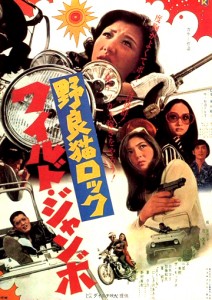AKA: Alleycat Rock: Wild Jumbo
Director: Toshiya Fujita
Producer: Toshiya Fujita, Shuichi Nagahara
Cast: Meiko Kaji, Bunjaku Han, Takeo Chii, Tatsuya Fuji, Yusuke Natsu, Soichiro Maeno, Akiko Wada
Running Time: 94 min.
By Kyle Warner
After the success of Stray Cat Rock: Delinquent Girl Boss, a follow-up film was rushed into production and released just three months later. Stray Cat Rock: Wild Jumbo is a messier, cheaper looking film than its predecessor, but somehow that doesn’t seem to matter. While the first film played with audience expectations and genre clichés, this movie just wants to have fun.
It’s obvious from the film’s opening scene with young people laughing and frolicking alongside the ocean that Wild Jumbo is going to be a very different kind of film. Gone is the gritty world of gangsters and desperate young people caught up in a world of violence. Wild Jumbo is a youth comedy – albeit one with a dangerous edge to it.
The film follows the Penguin Club, a group of five friends (Meiko Kaji, Tatsuya Fuji, Takeo Chii, Yusuke Natsu, Soichiro Maeno) who go from scene to scene goofing off and committing crimes in order to combat boredom. Early in the film the Penguin Club shoots out the tires of a rich girl’s car because they think she’d make a good match for Takeo Chii’s character Taki. The rich girl Asako (Bunjaku Han) inexplicably falls for Taki and the two start a romance which drives a bit of a wedge into the group of friends. As a way of making nice, Asako later goes to the Penguin Club with plans for a heist. The score will make them rich, but is it worth the risk?
Plot and drama are not the chief concerns of the filmmakers here. Stray Cat Rock: Wild Jumbo feels like a collection of scenes connected together by the loosest narrative possible. Not everybody is going to like this kind of free-form storytelling, but I personally think that the individual scenes are good enough that the film often works even if the plot itself remains largely nonexistent for much of the running time.
The major reason behind the dramatic shift in tone between films is that director Yasuharu Hasebe’s place has been taken by Toshiya Fujita. While Fujita’s Lady Snowblood films are well-known and revered by fans of cinema, the remainder of his filmography remains largely unseen in the US (his acting role in Seijun Suzuki’s masterpiece Zigeunerweisen was the only other time that I’ve seen a movie with his name in the credits). Not only is Fujita’s Stray Cat Rock film wildly different from Hasebe’s first foray in the series, it’s also stylistically very different from his own Lady Snowblood films. For someone with only a small sampling of Fujita’s work as a director, it’s difficult for me to say which genre he felt most comfortable in, because he handles both violent action and goofy counterculture comedy with a confident, authorial hand. Interestingly, over the course of Stray Cat Rock’s five film series, the films were split exclusively between Hasebe (films 1, 3, and 4) and Fujita (2 and 5). I’m reviewing these as I make my way through the series, so it’ll be interesting to see if the tone continues to switch back and forth between the two directors, or if one director’s style begins to rub off on the other.
By this time in the series, Meiko Kaji (The Blind Woman’s Curse) had cemented herself as the lead. However, the film works because of the ensemble of actors, all of whom bring the goods. Toshiya Fujita gives even minor actors like Soichiro Maeno, who plays the gun-obsessed Debo, scenes where they’re allowed to shine. Akiko Wada, the star of the first film, is given “Special Appearance” credit for Wild Jumbo… though all her scenes are really just stock footage taken from Delinquent Girl Boss. There’s one scene in which a character acknowledges her from across the street and the stock footage Akiko Wada is awkwardly unaware of his presence. It’s weird, but her ‘guest appearance’ and her music are a couple of the only things connecting the two films.
Not only was this film rushed to theatres just three months after its predecessor, but the third entry Sex Hunter was filmed simultaneously with Wild Jumbo, with actors splitting time between Hasebe’s and Fujita’s sets. It’s a chaotic, crazy way to make a movie. However, despite the hectic manner in which it was created, Wild Jumbo manages to feel like a personal, genuine sort of movie, and not the sort of cash grab that one usually associates with a rush to a release date.
In my favorite sequence of the film, the Penguin Club is driving along when a rival gang drives up and begins taunting them. Tatsuya Fuji can’t stand it, so he jumps out of the moving vehicle, steals a dump truck, and proceeds to chase after the rival’s car, repeatedly ramming them from behind. Instead of acting surprised or condemning his actions, the other members of the Penguin Club get their own dump trucks and join in on the fun. They’re all laughing and cheering as they repeatedly crash into a car and try to drive it off the road. It’s madness, but dammit I was laughing, too. The characters of Wild Jumbo are rebels without a cause – or a clue – and I enjoyed spending an hour and a half in their company. Certain films have been dubbed “hang out” movies over the years and I think Stray Cat Rock: Wild Jumbo fits into that category quite nicely. It’s weird, goofy piece of comic mischief that could have only come out of the 70s.
Kyle Warner’s Rating: 7/10




